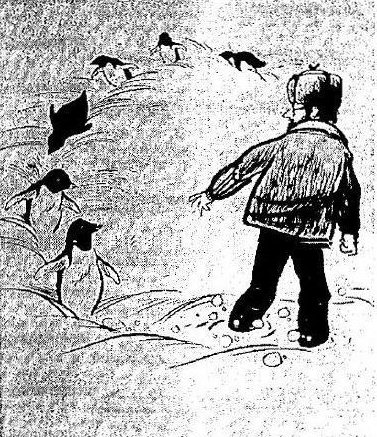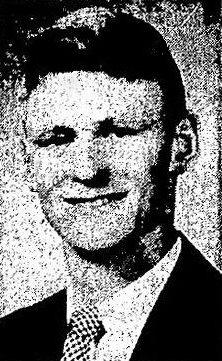|
Article #1
OSAGE MAN PENS SAGA OF PENGUINS (Courier News Service) OSAGE -- A former Osage resident, Dr. Richard L. Penney, is the author of a new children's science book, "The Penguins Are Coming!", published last week by Harper and Row.
Penney grew up in Osage, and is the son of Mrs. Hartley Penney, Osage, and the late Mr. Penney. He was greaduated from the Osage Community High School, and received his doctorate in zoology from the University of Wisconsin. He is now a research zoologist in the animal behavior laboratory of the New York Zoological Society at the Bronx Zoo. and an assistant professor at Rockefeller University. The book traces the life cycle of the Adelie penguins of Antartica. Penney's research on the book took him to Antartica five times for a total of 41 months. The easy-to-read 62 page book also features the art work of artist Tom Eaton. It was dedicated to the three Penney children, twins, David and Deanna, and Steven. Mrs. Penney is the former Pat Landborg of Osage, having grown up in Osage, and she, too, was graduated from the Osage Community High School. The book follows the Adelie penguins on their parade to the Antartic shore each spring, the building of nests of stone, the weeks without food while hatching the eggs ( a task shared by the males and females) and the chick's first jump into the frightening ocean waves. One review of the book says that in it Penney, "Conveys his own amusement and delight in these unique, noisy, and endearing birds." The review predicts that the book "will fascinate beginning readers." |
|
Article #2
Scientist Seeks to Learn Penguins' Homing Secrets By Lynn Poole
A Johns Hopkins University scientist has designed a special radio broadcasting set to attach on flippers of 20 penguins that will be released in the Antarctic. Radio messages from each penguin will be received at a central station, enabling the scientist to track the travel pattern of each penguin. Dr. Richard L. Penney, of the Johns Hopkins School of Hygiene and Public Health says, "We are interested in determining if these penguins, taken from their home areas, will orient themselves and follow a homing pattern when they waddle off across the snows of Antarctica. Much can be learned about their ability to find their way home, and the secrets of their navigational ability." In 1963 Dr. Penney performed an experiment with Adelie penguins, an Antarctic species weighing about 15 pounds. He found that the penguins consistently started in a direction with a definite relationship to their coastal homes. This study indicated that nature gives the nonflying, waddle-walking penguin an ability to find the sea and his rookery. The penguin has a built-in biological mechanism, used together with the position of the sun, that allows him to navigate home again. If the penguin is lost southeast or southwest of his shoreline rookery, he will walk due north instead of straight for home, and eventually reaches the sea. Dr. Penney now wants to know how and why the penguin is able to find his way home when he finally reaches the shoreline of the sea. Dr. Penney's first experiment with navigating penguins was in 1939 when he released five penguins at McMurdo Sound, in the Antarctic, 2,400 miles from their home. Three of them arrived in eight months. Since they do not travel at night, the three penguins had walked and swum about eight miles each day. His present investigation will begin this fall when his team will remove groups of penguins from several colonies, release them thousands of miles from home and follow them by radio during their long treks. Each penguin will have a small radio transmitter slung in a harness under one flipper. From an airplane investigators will follow the penguins by radio reception and map their progress as the birds plod their way across the white wastelands. Funds for this study, in the amount of $46,000, were made available to Dr. Penney by the Antarctic Research Program of the National Science Foundation. In planning the expedition and penguin tracking Dr. Penney had to negotiate with the Soviet Union because he hoL,os to use a number of penguins from the Russian base at Mirnyy, Funds for this study, in the amount of $46,000, were made available to Dr. Penney by the Antarctic Research Program of the National Science Foundation. In planning the expedition and penguin tracking Dr. Penney had to negotiate with the Soviet Union because he hopes to use a number of penguins from the Russian base at Mirnyy, in the Antarctic. When he has completed the on-the-spot navigational study of penguins, he will bring a number back to Baltimore, where in his Johns Hopkins laboratory he will carry on a study of the biological mechanisms used by the penguins in their navigation across the frozen snow, and through near-freezing water. "From File 7" is a weekly
|
|
Article #3
OSAGE MAN LEAVES FOR ANTARCTICA
Penney's field is biological science. He will be the principal investigator for the University of Wisconsin, with a special grant from the National Science Foundation, National Academy of Sciences Committee of Polar Research. Penney will be the only biologist in the group which includes 12 Australians. This is the first year this phase of the work has been stressed. PENNEY WAS granted an assistantship in the graduate school at the University of Wisconsin, department of zoology, following graduation from St. Olaf College. He was selected for the polar assignment because of research work he has done. His particular interests were "the sexual and parental behavior of Adelie Penguins" and "The orientation mechanism of Adelie Penguins." Penney's itinerary is: Madison by plane to Washington, D.C.; then via MATS to California, Hawaii, Canton, Fiji Islands, New Zealand, McMurdo Sound, Antarctica. THERE HE WILL board the USS Staten Island, an icebreaker, for the trip to Wilkes Station on the windy side of the pole. The men will be stationed there for 16 months, with no mail, no outside food, almost complete isolation. Penney's wife, the former Pat Landborg, Osage, and three children, twins, David Lee and Deanna Lynn, 2 1/2, and Steven Hartley, 3 months, will remain in Madison. "Sixteen months is a long time," says Penney. "But with a capable wife to care for the children there will be no worry." |
Webization by Kermit Kittleson, July 2009
©2009 IaGenWeb

